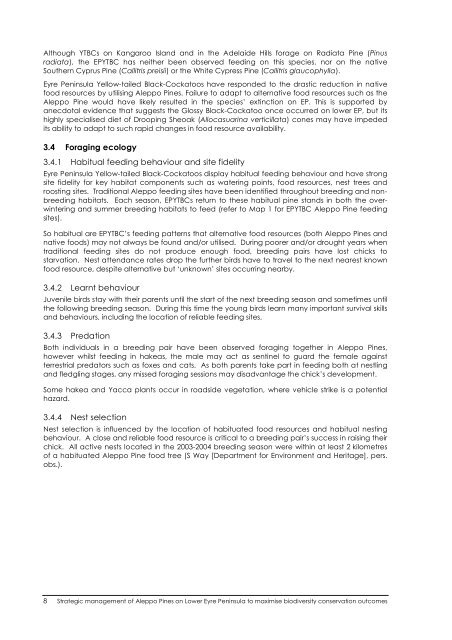Strategic management of Aleppo Pines on Lower Eyre
Strategic management of Aleppo Pines on Lower Eyre
Strategic management of Aleppo Pines on Lower Eyre
You also want an ePaper? Increase the reach of your titles
YUMPU automatically turns print PDFs into web optimized ePapers that Google loves.
Although YTBCs <strong>on</strong> Kangaroo Island and in the Adelaide Hills forage <strong>on</strong> Radiata Pine (Pinus<br />
radiata), the EPYTBC has neither been observed feeding <strong>on</strong> this species, nor <strong>on</strong> the native<br />
Southern Cyprus Pine (Callitris preisii) or the White Cypress Pine (Callitris glaucophylla).<br />
<strong>Eyre</strong> Peninsula Yellow-tailed Black-Cockatoos have resp<strong>on</strong>ded to the drastic reducti<strong>on</strong> in native<br />
food resources by utilising <str<strong>on</strong>g>Aleppo</str<strong>on</strong>g> <str<strong>on</strong>g>Pines</str<strong>on</strong>g>. Failure to adapt to alternative food resources such as the<br />
<str<strong>on</strong>g>Aleppo</str<strong>on</strong>g> Pine would have likely resulted in the species’ extincti<strong>on</strong> <strong>on</strong> EP. This is supported by<br />
anecdotal evidence that suggests the Glossy Black-Cockatoo <strong>on</strong>ce occurred <strong>on</strong> lower EP, but its<br />
highly specialised diet <str<strong>on</strong>g>of</str<strong>on</strong>g> Drooping Sheoak (Allocasuarina verticillata) c<strong>on</strong>es may have impeded<br />
its ability to adapt to such rapid changes in food resource availability.<br />
3.4 Foraging ecology<br />
3.4.1 Habitual feeding behaviour and site fidelity<br />
<strong>Eyre</strong> Peninsula Yellow-tailed Black-Cockatoos display habitual feeding behaviour and have str<strong>on</strong>g<br />
site fidelity for key habitat comp<strong>on</strong>ents such as watering points, food resources, nest trees and<br />
roosting sites. Traditi<strong>on</strong>al <str<strong>on</strong>g>Aleppo</str<strong>on</strong>g> feeding sites have been identified throughout breeding and n<strong>on</strong>breeding<br />
habitats. Each seas<strong>on</strong>, EPYTBCs return to these habitual pine stands in both the overwintering<br />
and summer breeding habitats to feed (refer to Map 1 for EPYTBC <str<strong>on</strong>g>Aleppo</str<strong>on</strong>g> Pine feeding<br />
sites).<br />
So habitual are EPYTBC’s feeding patterns that alternative food resources (both <str<strong>on</strong>g>Aleppo</str<strong>on</strong>g> <str<strong>on</strong>g>Pines</str<strong>on</strong>g> and<br />
native foods) may not always be found and/or utilised. During poorer and/or drought years when<br />
traditi<strong>on</strong>al feeding sites do not produce enough food, breeding pairs have lost chicks to<br />
starvati<strong>on</strong>. Nest attendance rates drop the further birds have to travel to the next nearest known<br />
food resource, despite alternative but ‘unknown’ sites occurring nearby.<br />
3.4.2 Learnt behaviour<br />
Juvenile birds stay with their parents until the start <str<strong>on</strong>g>of</str<strong>on</strong>g> the next breeding seas<strong>on</strong> and sometimes until<br />
the following breeding seas<strong>on</strong>. During this time the young birds learn many important survival skills<br />
and behaviours, including the locati<strong>on</strong> <str<strong>on</strong>g>of</str<strong>on</strong>g> reliable feeding sites.<br />
3.4.3 Predati<strong>on</strong><br />
Both individuals in a breeding pair have been observed foraging together in <str<strong>on</strong>g>Aleppo</str<strong>on</strong>g> <str<strong>on</strong>g>Pines</str<strong>on</strong>g>,<br />
however whilst feeding in hakeas, the male may act as sentinel to guard the female against<br />
terrestrial predators such as foxes and cats. As both parents take part in feeding both at nestling<br />
and fledgling stages, any missed foraging sessi<strong>on</strong>s may disadvantage the chick’s development.<br />
Some hakea and Yacca plants occur in roadside vegetati<strong>on</strong>, where vehicle strike is a potential<br />
hazard.<br />
3.4.4 Nest selecti<strong>on</strong><br />
Nest selecti<strong>on</strong> is influenced by the locati<strong>on</strong> <str<strong>on</strong>g>of</str<strong>on</strong>g> habituated food resources and habitual nesting<br />
behaviour. A close and reliable food resource is critical to a breeding pair’s success in raising their<br />
chick. All active nests located in the 2003-2004 breeding seas<strong>on</strong> were within at least 2 kilometres<br />
<str<strong>on</strong>g>of</str<strong>on</strong>g> a habituated <str<strong>on</strong>g>Aleppo</str<strong>on</strong>g> Pine food tree (S Way [Department for Envir<strong>on</strong>ment and Heritage], pers.<br />
obs.).<br />
8<br />
<str<strong>on</strong>g>Strategic</str<strong>on</strong>g> <str<strong>on</strong>g>management</str<strong>on</strong>g> <str<strong>on</strong>g>of</str<strong>on</strong>g> <str<strong>on</strong>g>Aleppo</str<strong>on</strong>g> <str<strong>on</strong>g>Pines</str<strong>on</strong>g> <strong>on</strong> <strong>Lower</strong> <strong>Eyre</strong> Peninsula to maximise biodiversity c<strong>on</strong>servati<strong>on</strong> outcomes

















